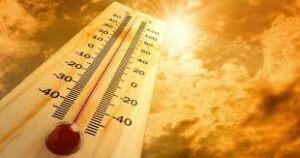GS 3 – ENVIRONMENT

Context:
The first half of 2025 has seen a series of weather anomalies across India, highlighting the deepening impacts of climate change on urban environments, marked by abnormal temperatures, erratic rainfall, elevated humidity, and increasing urban fragility.
Rising Humidity: Key Drivers
- Warming Oceans: Elevated sea surface temperatures enhance evaporation rates, increasing atmospheric moisture.
- Frequent Low-Pressure Zones: More depressions over the Bay of Bengal push moist air further inland.
- Urban Surface Sealing: Extensive use of impervious materials like concrete limits natural evaporation.
- Declining Urban Greenery: Reduction in trees and green spaces cuts down transpiration-based cooling.
- Monsoon Irregularities: Delayed and inconsistent rainfall leads to prolonged pre-monsoon humidity spells.
Urban Areas: Epicenters of Climate Vulnerability
- Dense Populations: Urban crowding amplifies disaster risks and complicates relief efforts.
- Heat-Trapping Materials: Asphalt and concrete retain daytime heat, worsening urban temperatures.
- Inadequate Drainage: Poorly planned infrastructure leads to urban flooding after minimal rainfall.
- Urban Canyon Effect: Closely spaced tall buildings hinder airflow and trap heat.
Understanding the Urban Heat Island (UHI) Effect
Urban Heat Island is a localized warming phenomenon where parts of a city experience significantly higher temperatures than nearby rural or open areas due to:
- Thermal Retention: Buildings and roads absorb heat during the day and release it slowly at night.
- Anthropogenic Heat Sources: Emissions from vehicles, air conditioners, and industries add to the heat burden.
- Airflow Obstruction: Skyscrapers restrict wind movement, intensifying radiant heat retention.
- Pollution Haze: A layer of pollutants traps heat, raising night-time temperatures.
Compounding Impact of Humidity
- Economic Losses: Heat-related damages cost the global economy approximately US$624 billion annually.
- Employment Challenges: An estimated 34 million jobs could be impacted in the next five years (World Bank).
- Labour Productivity Decline: From 2001 to 2020, heat stress caused the loss of 259 billion work hours annually.
- Health Risks: Excess humidity hampers sweating, leading to heat exhaustion, dehydration, and sleep disorders.
- Lightning Fatalities: Enhanced convection due to humidity has increased lightning strikes — over 150 deaths reported in Bihar in March–April 2025.
- Post-Harvest Losses: High humidity causes spoilage of perishables and reduces shelf life of crops, affecting commodities like wheat, rice, and sugarcane.
- Energy Burden: Humidity worsens the UHI effect, pushing up electricity demand and overloading power infrastructure.
Strategies for Building Urban Climate Resilience
Structural Approaches
- Infrastructure Audits: Conduct periodic reviews to identify vulnerabilities in urban infrastructure and upgrade accordingly.
- Decentralized Energy Systems: Promote solar rooftops, microgrids, and biogas units to maintain energy security during climate disruptions.
- Climate-Resilient Housing: Update building codes to include cool roofing, passive ventilation, and retrofitting support for vulnerable localities.
- Example: Hyderabad’s cool roof initiative serves as a replicable model.
- Coastal Urban Planning: Modify coastal architecture with raised foundations, mangrove buffers, and adaptive zoning laws.
Non-Structural Measures
- Advanced Alerts: Use AI-driven forecasting systems and community apps for real-time updates on extreme weather events.
- Climate-Focused Budgeting: Integrate resilience metrics into municipal budgeting and planning processes.
- Dedicated Resilience Units: Set up Urban Climate Resilience Cells at the local and state levels to streamline policy, data management, and emergency coordination.
Global Best Practices in Urban Climate Adaptation
| City | Initiative |
| Paris | Mandatory green roofs or solar panels on new commercial structures |
| Singapore | Vertical gardens and rooftop parks to mitigate urban heat |
| Netherlands | Parks designed to act as stormwater retention zones |
| Tokyo | Green Credit System incentivizing private developers to create green space |
| New York | Climate-resilient infrastructure standards for future-proofing |
| Copenhagen | Integrated blue–green stormwater systems to prevent flooding |




